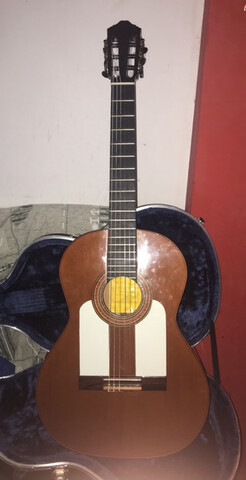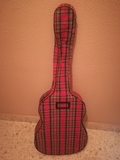Juan Estruch Guitarra Blue Label 2017 Sold $200.00 1 Bid, FREE Shipping Estimate, Click to see shipping cost, eBay Money Back Guarantee Seller: timilovesguitars (40) 0%, Location: Richmond, Indiana, Ships to: US, Item: 44 JUAN ESTRUCH Classical Guitars were made in Barcelona, Spain. Juan Estruch Concerto model 2 1972 / Juan Estruch 1920 / 1930 A 1972 Concerto II model of this Barcelona based. In fact a factory made instrument but with the. Quality of a hand built one. In pristine condition as it has. Hardly been played. 645 mm scale and a traditional.
Save juan estruch guitar to get e-mail alerts and updates on your eBay Feed. + Items in search results. 2006 Juan Estruch Gran Concierto Especial Classical Guitar. LUTHIER JUAN NOGUERO. Buy It Now +$85.00 shipping. RED GUM FLAMENCO GUITAR JUAN MONTES SPANISH GUITAR CASE 2019. Crafted in Guatemala, Zacapa Rum is a work of art, and an expression of patience, richness, quality and master blending. Aged to perfection in the highlands of Quetzaltenango, Zacapa Rum develops its complex flavour and character 2,300m above sea level in the mystical House Above the Clouds.
Seller:timilovesguitars(40)0%, Location:Richmond, Indiana, Ships to: US, Item:282697488744JUAN ESTRUCH Classical Guitars were made in Barcelona, Spain. They are a very high quality instrument. Many claim that the one they have or had is the best sounding classical guitar they have ever played or heard. At the time of this listing there are 4 here on eBay. They are priced at $1,800, $2,500, $3,450 and $4,000. My friend who is also the greatest guitarist I know tried one in Cincinnati, which he said was far superior to his 1A Jose Ramirez in every way. It was priced at $7,000. Now this guitar is not full size. I bought it thinking it was, as the eBay seller did not provide measurements or mention that it was under sized. I do not know if it is some sort of special Spanish model, or a young student model, or what. But here are the measurements in inches: Over all length: 34 5/8' Body Length: 15 1/2' Nut width 2' Upper bout: 9 1/2' Lower bout 12 1/4' Scale: 21' Sound Hole: 3 3/8' Body depth: 3 7/8' So you can see it is shorter with a smaller body, while other measurements are standard, like the body depth, the sound hole and the top nut. You can see from the pictures that the guitar is made from the same quality solid tone woods, has the same label, has the same type of body binding, the same headstock as most models (the headstock and label changed over the years), the same level of craftsmanship, etc., but is simple smaller in size. Very interesting. Possibly a rare collectors piece. There are scratches and small dings everywhere, but nothing major. It appears to be all original with no repairs. There are no cracks as with several models. It is in very good condition I think for it's age and comparing it to several others made by the same luthier. I have no idea of the guitars value. So I will start the bidding at $200 and let you decide, with no reserves on the listing. Sorry no overseas bids.Condition:Used, Brand:JUAN ESTRUCH, Country/Region of Manufacture:Spain, Body Type:Standard, Model:Juan Estruach, Dexterity:Right-Handed, String Configuration:6 String
PicClick Insights for 'JUAN ESTRUCH Classical Guitar, Barcelona, Spain, Vintage
'PicClick Exclusive- Popularity - 0 views, 0 views per day, 630 days on eBay. 1 sold, 0 available. 1 bid.
- Price -
- Seller - 40+ items sold. 0% negative feedback. Good seller with good positive feedback and good amount of ratings.
0 views, 0 views per day, 630 days on eBay. 1 sold, 0 available. 1 bid.
40+ items sold. 0% negative feedback. Good seller with good positive feedback and good amount of ratings.
Recent Feedback
JUAN ESTRUCH Classical Guitar, Barcelona, Spain, Vintage
'PicClick ExclusiveVintage Juan Estruch Classical Guitar Barcelona Spanish Flamenco Acoustic 60-69
$600.00Buy It Nowor Best Offer29d 9h1982 Juan Estruch C-1 Brazilian Rosewood Classical Guitar
1957 Juan Estruch Barcelona / Spain Classical Guitar w/ original case Flamenco
$2,745.00Buy It Now21d 11h1958 Juan Estruch African Mahogany Classical Guitar
1958 Juan Estruch Brazilian Rosewood Concert Classical Guitar
$1,750.00Buy It Nowor Best Offer20d 3hJuan Estruch 1975 Klassische Gitarre 'Yellow Label' (Chet Atkins) - sagenhaft!!
Classical Guitars
The classical guitar, used in classical music pieces, is one of many guitars that has evolved and changed. Differing musical compositions, styles of play, and materials of construction differentiate the classical guitar from other guitars. With roots dating back as far as four centuries, contemporary classical guitars let you play beautiful music.
What are the features of classical guitars?The classical guitar is an acoustical wooden guitar with the following features:
- Strings: These guitars use soft nylon strings.
- Body: The eight-figure shape is a classical body shape. It has a scale length of 26 inches and an overall length of 38 inches to 40 inches.
- Frets: Classical guitars have 12 frets.
Juan Estruch Guitarra Blue Label 2017
Classical guitars are stringed instruments constructed of various woods that are chosen for their grain qualities, stiffness, and finished tone. Different woods can be used to construct each part of the guitar, including the neck and head, fingerboard, top, sides, back, and bridge. Some of the types of wood used to construct classical guitars include: Tokyo ghoul game pc download.
- Ebony
- Rosewood
- Mahogony
- Blackwood
- Spruce
Classical guitars use nylon strings that produce a soft sound. Nylon strings have replaced the cat gut strings that were used on earlier classical guitars. Nylon strings are also softer on the fingers and allow you to use your fingers as picks. The string-load tension on a classical guitar is somewhat low, allowing the player to easily press the strings to the fretboard.
Best PLAYERS. There are many great players in SWOS, and everybody will have thier own secret players that they have discovered during the game. This is my list of best players, some are great bargain buys which are very useful if your club is on a small budget. Some are more well known players who I think are the very best on the game. Author Topic: Best player in SWOS 96/97 (Read 52368 times) 0 Members and 1 Guest are viewing this topic. I think there are many Great players in SWOS. This is my altime best Squad from AMIGA 94/95 Edt FIRST XI GK: Luis Henrique RB: Iain Jenkins. Swos 96 97 best cheap players. : The comparison function is now fixed - apologies for any inconvenience with that, and thank you (as ever) to Playaveli for pointing it out! These are, as far as I'm concerned, some of the best players in Sensible Soccer, ONLY in version 96/97, with a small but pertinent singularity.none of them is over £1, in the act of purchase.they can outnumber that value in the long term, but nothing over one million pounds when the player is bought. Jan 11, 2008 does anyone know who are the best cheap players to buy,i just started in division 3 in england and bought mooneyfom wtford as alt folk seem to think he is good but he did not seem up to much for,please help me.
How can you store a classical guitar?Fl studio pattern not playing. Because a classical guitar is a finely tuned instrument crafted from natural wood, it is important to store it properly to preserve the guitar. Proper storage techniques include:
- 1. Ideally, keep the guitar stored at a steady temperature of 65 to 75 degrees Fahrenheit and at a 45% to 55% humidity.
- 2. Never leave the guitar near a dry heat or dry air source. You should also avoid leaving the guitar near any water source indoors or outdoors Both of these steps help to maintain a proper humidity level for the guitar.
- 3. When not in use, store the guitar in a well-fitted case with a weather seal and hard-shell exterior. When traveling with the guitar in the case for long periods of time, you might consider placing a two-way humidification system within the case to prevent drying.
- 4. Use a chamois cloth to gently wipe down the finish of the wood to remove fingerprints and oils from your fingers and hands after playing.



Juan Estruch Guitar Value

Juan Estruch Guitar
Juan Estruch Classical Guitar
